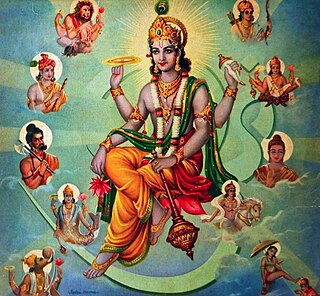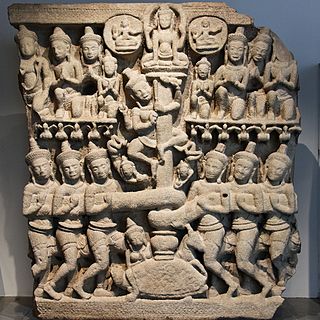
Varaha is an avatar of the Hindu god Vishnu, in the form of a boar. Varaha is generally listed as third in the Dashavatara, the ten principal avatars of Vishnu.

Vamana, also known as Trivikrama, Urukrama (transl. far-stepping), Upendra, Dadhivamana, and Balibandhana is an avatar of the Hindu deity Vishnu. He is the fifth avatar of Vishnu, and the first Dashavatara in the Treta Yuga, after Narasimha.

Avatar, is a concept within Hinduism that in Sanskrit literally means "descent". It signifies the material appearance or incarnation of a powerful deity, goddess or spirit on Earth. The relative verb to "alight, to make one's appearance" is sometimes used to refer to any guru or revered human being.

Chiranjivi are the eight immortals who are to remain alive on Earth until the end of the current Kali Yuga, according to Hinduism. The Sanskrit term Chiranjivi means “immortal”, even though it does not correspond with “eternal”. The term is a combination of "chiram" (long) and jivi (lived).

The Chennakesava Temple, also referred to as Chennakeshava Temple and Keshava Temple, is a Vaishnava Hindu temple on the banks of River Kaveri at Somanathapura, Karnataka, India. The temple was consecrated in 1258 CE by Somanatha Dandanayaka, a general of the Hoysala King Narasimha III. It is located 38 kilometres (24 mi) east of Mysuru city.

Hindu mythological wars are the wars described in the Hindu texts of ancient India. These wars depicted both mortals of great prowess as well as deities and supernatural beings, often wielding supernatural weapons of great power. Hindu teachings prescribe war as the final option, to be employed only after all peaceful methods are exhausted. Participation in righteous war, or dharmayuddha, was said to be honourable and was a principal duty of the Kshatriya or the warrior varna, and victory in such wars was regarded as a matter of honour.

Kaumodaki is the gadā (mace) of the Hindu deity Vishnu. Vishnu is often depicted holding the Kaumodaki in one of his four hands; his other attributes are the chakra, the conch, and the lotus. The gada is also found in the iconography of some of Vishnu's avatars.

Thrikkakara Vamanamoorthy Temple is one of the few Hindu temples in India dedicated to Lord Vamana/Vishnu. It is situated in Thrikkakara, Kochi in the state of Kerala, India. Located around 10 km north-east of the city center between Thrissur-Ernakulam highway, Seaport-Airport Road, Cochin University of Science and Technology and Model Engineering College, it is a centre of celebrations and a place of origin for the popular Onam festival. The temple is around two millennia old and is also listed as one of the 108 Divya Desams.

Chennakeshava Temple, also referred to as Keshava, Kesava or Vijayanarayana Temple of Belur, is a 12th-century Hindu temple in the Hassan district of Karnataka state, India. It was commissioned by King Vishnuvardhana in 1117 CE, on the banks of the Yagachi River in Belur also called Velapura, an early Hoysala Empire capital. The temple was built over three generations and took 103 years to finish. It was repeatedly damaged and plundered during wars, repeatedly rebuilt and repaired over its history. It is 35 km from Hassan city and about 200 km from Bengaluru.
Darwin's theory of evolution has influenced modernist interpretations of Hindu philosophy, especially reincarnation and human development. Hindus have found support for, or ideas foreshadowing evolutionary ideas, in scriptures, such as the mytheme of Dashavatara, the incarnations of Vishnu starting with a fish.

The Dashavatara are the ten primary avatars of Vishnu, a principal Hindu god. Vishnu is said to descend in the form of an avatar to restore cosmic order. The word Dashavatara derives from daśa, meaning "ten", and avatāra, roughly equivalent to "incarnation".

Dashavatar is a 2008 animated film based on the ten incarnations of Lord Vishnu.

Kodandaramaswami Temple is a Hindu shrine located at Hiremagalur near Chikkamagaluru, in Chikkamagaluru district, Karnataka, India. The temple deity is called Kodandarama, as Rama, and his brother Lakshmana are depicted holding arrows.

Andhra Vishnu, better known as Srikakula Mahavishnu statue, was set up in Andhra in a pre-existing older temple. The previous deistic form worshiped in the temple is unknown.

Vishvarupa is an iconographical form and theophany of a Hindu deity, most commonly associated with Vishnu in contemporary Hinduism. Though there are multiple Vishvarupa theophanies, the most celebrated is in the Bhagavad Gita, given by Krishna in the epic Mahabharata, which was told to Pandava prince Arjuna on the battlefield of Kurukshetra in the war between the Pandavas and Kauravas. Vishvarupa is considered the supreme form of Vishnu, where the whole universe is described as contained within him.

The Varahanatha Temple, also known as Yajna Varaha Temple, is a Hindu temple complex, located on the left bank of the Vaitarani River on an island formed by the river, in Jajpur, Odisha, India. The main shrine is dedicated to Varaha, the boar avatar of the god Vishnu. Built in 15-16th century, the temple is constructed in Kalinga architectural style. Besides the central Varaha shrine, there are numerous subordinate shrines to deities like Shiva, Vishnu, Vimala and others.

Chaubis Avtar, meaning Twenty Four Incarnations, is a composition in Dasam Granth containing history of 24 incarnations of Vishnu. It is traditionally and historically attributed to Guru Gobind Singh. The composition covers 30% of the Dasam Granth containing 5571 verses with longest sub compositions being Krishna Avtar and Rama avtar, having 2492 and 864 verses each. Kalki avtar chapter contains 586 Verses.

Dasavatharam is a 1976 Indian Tamil-language Hindu mythological film, directed and written by K. S. Gopalakrishnan. The film, based on the Dashavatara of Vishnu, stars Ravikumar, with Sirkazhi Govindarajan, Jayachitra, Gemini Ganesan, M. R. Radha, P. S. Veerappa, Sowcar Janaki and K. R. Vijaya in supporting roles. It was released on 15 January 1976.

The Shri Siddheshwar temple complex in Toka village is another finest example of Yadava architecture during 12th-13th century in Marathwada region. After the establishment of the Marathi state, new temples were built during the Peshwa period. There are plenty of sculptures out there. The temple consists of many sculptures from many epic stories or character like Ramayan, Mahabharata, Puranas, Surasundari, Vyal-Sharbha. However, it is not as delicate and diverse as the temple sculptures during the Yadav period. The temple has a big Shivlingam inside the sanctum, with the brass snake and the idol of Parvati in the back wall.
















